Tel: 01288 331251 |  |
| 


Local History
The Parish of Morwenstow
The civil parish of Morwenstow is located about 6 miles from Bude on the North coast of Cornwall.
The Parish of Morwenstow most likely derived it’s name from: St. Morwenna (born around AD 480) (Logmorwenna in Cornish, Morwyn in Welsh, Morwenna in Latin and Morwen in English).
She is believed to have been the daughter of St. Necterin, who was very likely King Brychan Brycheiniog of the region which we now know as Brecon in Wales. King Brychan Brycheiniog was originally from Ireland, the home of Celtic Christianity, which was gradually spreading into England. Morwenna was probably trained in Ireland before she crossed to Cornwall where she made her home in a small hermitage known as Hennacliff (Raven’s Crag). This later became known as Morwenstow.
The Church of St. Morwenna and St. John the Baptist
Morwenstow Church is dedicated to the Saints John the Baptist and Morwenna.
The earliest parts of the current Church are Norman however, it is believed that an earlier Saxon Church stood on the site previously. It has been suggested that the font may have been inherited from this earlier Saxon Church based on its cable decoration. In a document dated 1296, the Church was referred to as an ‘old and well-known structure’.
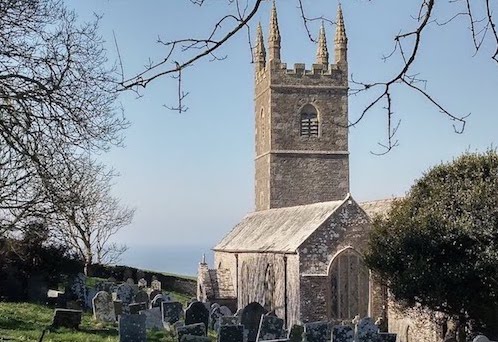
The Saxon Church may not even be the oldest religious building to have existed on this site. There is also strong evidence that the area has been occupied as far back as the Stone Age. A Bronze axe head was found in West Youlstone and a hill fort was located in the area on Stanbury Manor.
Additions were made to the Church in the 1400s, 1600s and 1700s. In the 1850s the box pews were removed and the wooden roof shingles on the roof were replaced. A further restoration took place around 1878, a Vestry was added in 1887 and there were further restorations in 1904 and 1908. And in 1934 the colouring of the chancel roof was restored.
The Organ was built by J. W. Walker & Sons Ltd. of London in 1892 and rebuilt by Geo. Osmond of Taunton in 1969.
The Church has eight bells and a group of enthusiastic bell ringers. Four of the bells were cast in 1753 by Abel Rudhall, and two of the others were cast by Mears and Stainback of the Whitechapel Bell Foundary in 1902.
At the entry to the churchyard are an adjoining stile, a lychgate and a small stone building. The stile dates from the 19th century and was probably designed by Parson Hawker. It is constructed from freestone ashlar and slate.
The lychgate, which is wooden with a slate roof, was built in 1641 and extensively repaired in 1738. And the stone building which is now used as a store was at one point used as a temporary mortuary for laying out the drowned sailors from the shipwrecks along the coast.
About 125 metres from the Church in the Vicarage garden is the holy well of St. John, over which is a medieval well house. For centuries the water from this well has been used for baptisms and it is still used for this purpose today.
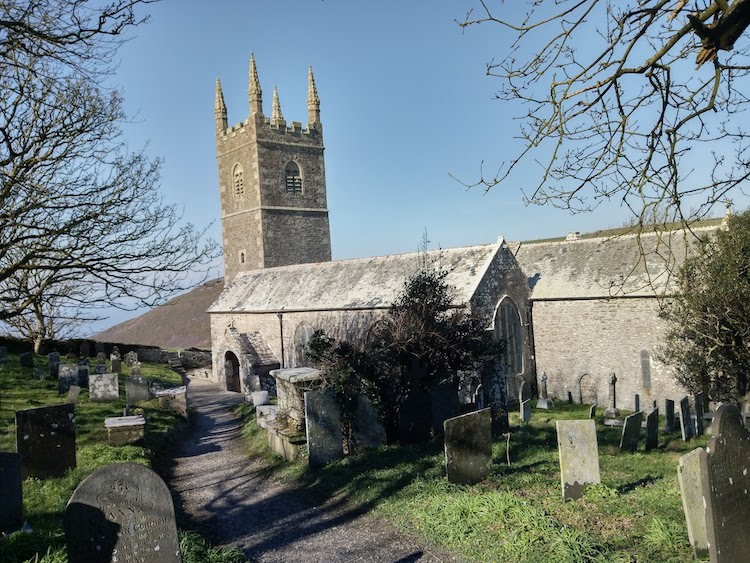
And to the west of the Church about 14 metres down the cliff is the holy well of St. Morwenna, who’s well house also originates from the medieval period.
Morwenna is said to have built a church for the local people with her own hands. The legend says that she carried the stone for the church on her head from beneath the cliff and that where she once stopped to rest a spring gushed forth. The spring can still be seen to the west of the church.
Inside the Church there are memorial windows dating from the 19th century which contain fragments of medieval glass. They commemorate the Waddon Martyns of Tonacombe who were an important family in the Parish. There is also a window commemorating Reverend Hawker and his family. Reverend Hawker’s first wife also rests between the pulpit and lectern.
Shipwrecks
"From Pentire Point to Hartland Light, a watery grave by day or night"
The Cornish Coast has infamously been known as being treacherous to ships for centuries because of its stormy and unpredictable nature, and between 1824 and 1874 there were more than eighty shipwrecks recorded along this stretch of the North Cornwall Coast.
There are two main shipwrecks from the Morwenstow area that are memorialised within the Church grounds, the ‘Caledonia’ and the ‘Alonzo’. The wreck of the Caledonia was the first major disaster to happen after the Reverend Hawker took up residence in Morwenstow.
In the early hours of the 8th September 1842 the 200 ton Scottish brig the ‘Caledonia of Arbroath’ ran aground off Sharpnose Point, just along the coast from Morwenstow Church. All but one of the Caledonia’s crew was lost and were laid to rest in the Morwenstow Churchyard beneath the figurehead from their ship. The figurehead of the Caledonia is a depiction of a Scottish Amazon complete with sword, shield, Tam’o shanter and sporran. She has become known locally as the ‘Last Virgin of Morwenstow’.
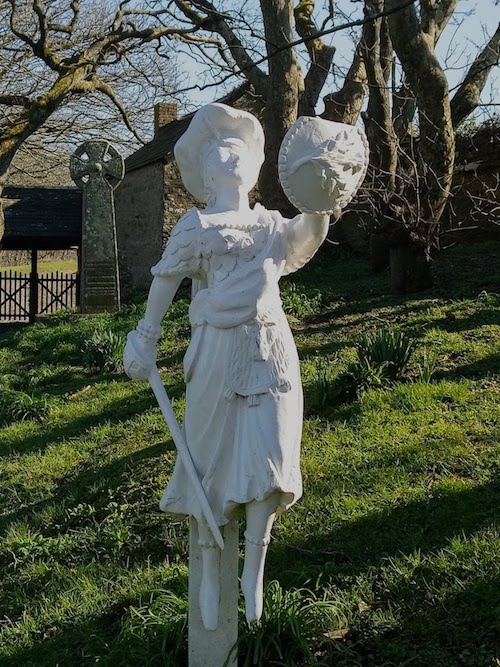
She marked the final resting place of the Caledonia’s crew for nearly 200 years until it was decided in 2004 that the original figurehead should be removed for conservation and would be replaced with a replica, whilst the original would be placed inside the Church, so as to be better protected from the elements.
Standing near the replica figurehead of the Caledonia is a carved granite Cornish cross marked with the words “Unknown Yet Well Known” marking the area where more sailors who lost their lives along the Morwenstow coastline were laid to rest by the Reverend Hawker. Amongst them is the Captain of the Alonzo, and many of her crew.
Robert Stephen Hawker (1803 - 1875)
Morwenstow is noted as having been the home of the eccentric vicar Robert Stephen Hawker, who is credited with having written Cornwall's anthem 'Trelawney'.
He was born in the clergy house of Charles Church, Plymouth, on 3rd December 1803. Soon after his birth, his father took holy orders and became the curate of Stratton.
He attended Oxford University and received his degree in 1828 and then took Church of England Orders in 1831. Whilst an undergraduate at Oxford, Robert met his first wife, Charlotte Eliza I'ans then aged 41. After serving as the curate at Tamerton in North Cornwall, he was then appointed as the Vicar for Morwenstow in 1834.
In 1844, Hawker built his clifftop retreat, now known as Hawker's Hut and it is the smallest building maintained by the National Trust. He is reported to have built his hut from driftwood and recovered shipwreck timbers according to his biographer and son-in-law, C. E. Byles. Hawker is reported to have even entertained guests at his clifftop retreat, including Alfred Tennyson and Charles Kingsley.
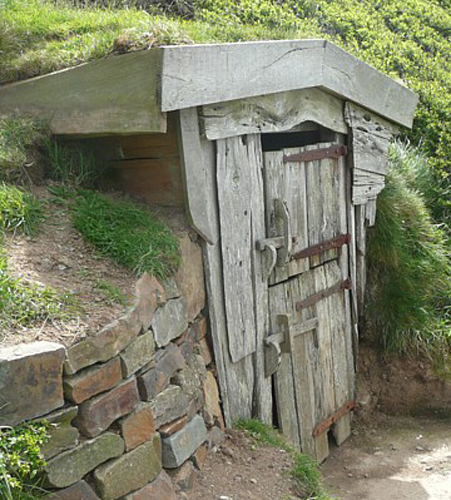
After the death of his first wife Charlotte, in 1863, Hawker married Pauline Kuczynski in 1864. Together they had three daughters; Morwenna Pauline, Rosalind and Juliet Hawker.
Robert Stephen Hawker died on the 15th August 1875, having converted to Catholicism on his deathbed. He was buried in the Ford Park Cemetary in Plymouth with his second wife Pauline.
Of his interesting life, Hawker himself wrote:
"What a life mine would be if it were all written and published in a book."
Local Area and Walks
There are two main walks that centre around The Rectory Farm Tearooms.
The shorter of these is the Hawker's Hut Walk. Which is approximately 1 mile (or 1.6km) long.
And for those who want a bit more of a challenge Morwenstow Walk: Reverend Walker Country. Which is approximately 3 miles (or 4.8km) long. Both walks are dog friendly and end back at the Rectory Tearooms, perfect for some well deserved refreshments.
Lundy Island
Off the North East Coast of Morwenstow can be seen Lundy Island. It lies about 12 miles (19km) off the coast of Devon and Cornwall. The name is believed to have been introduced by the Vikings in around the 9th Century. The name Lund-ey, meaning Puffin Island.
Archaeological investigations have found considerable evidence of Bronze and Iron Age settlements meaning that the island has been inhabited for at least 3000 years.
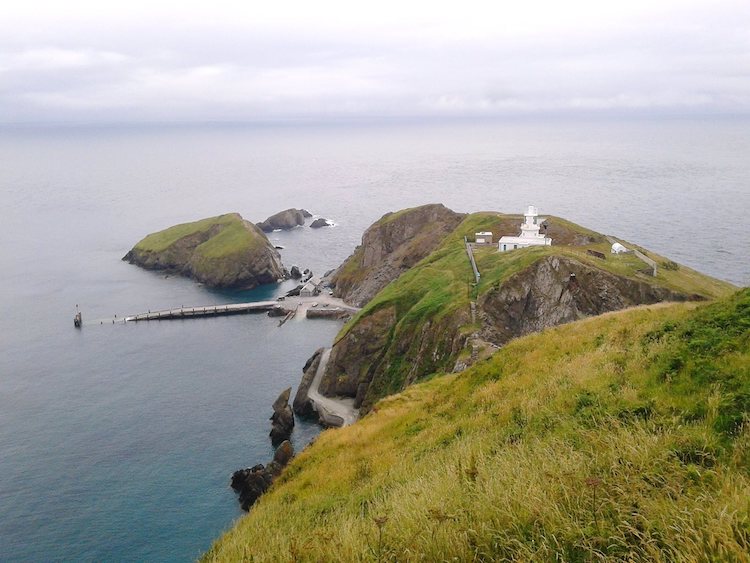
On 12th January 2010 the island became Britain's first Marine Conservation Zone designated under the Marine and Coastal Access Act 2009, designed to help preserve important habitats and species.
RAF Cleave
During the Second World War there were a few airfields established throughout Cornwall. One of these, RAF Cleave, was based at Morwenstow. Although it did see some periods of intense activity it was one of the lesser used airfields, partially due to the weather.
From May 1939 the G and V Flights of the No. 1 Anti-Aircraft Co-operation Unit (AACU) were stationed here. There were also Westland Wallace biplanes and later Hawker Henley's. As well as radio controlled 'Queen Bee' drones launched from the cliff using compressed air.
Even though the facilities at the airfield would gradually improve, the airfields location would ensure that it would play a limited role in the Second World War.
All websites listed below were accessed in March and April 2018.
- Wikipedia - Morwenstow
- Into Cornwall - Morwenstow
- Morwenstow Church - Intro and Caledonia
- CHCT Website - Morwenstow - St Morwenna and St John the Baptist
- Cornwall Calling Website - Morwenstow Church
- Robert Stephen Hawker - The Church of St Morwenna and St John
- Hawker of Morwenstow: Portriat of an Eccentric Victorian. Piers Brendon. Random House, 31 Aug 2011.
- Atlas Obscura - Hawker's Hut
- BBC Cornwall, Local History. Caledonia Remembered - 13th November 2014.
- Submerged Website - Caledonia
- Wiki2.org Website - List of Shipwrecks of Cornwall (19th Century)
- Historic England - Pastscape - Alonzo.
- The Wreckers A story of killing seas, false lights and plundered ships by Bella Bathurst. Harper Perennial, London, 2006
- South West Coast Path Walk - Hawkers Hut
- The National Trust - Morwenstow Walk - Reverend Hawker Country
- The National Trust - Hawker's Hut Walk
- Wikipedia - Lundy
- The Landmark Trust - Lundy Island History
- Cornwall at War 1939 - 1945 by Peter Hancock. Halsgrove House, Tiverton, 2002